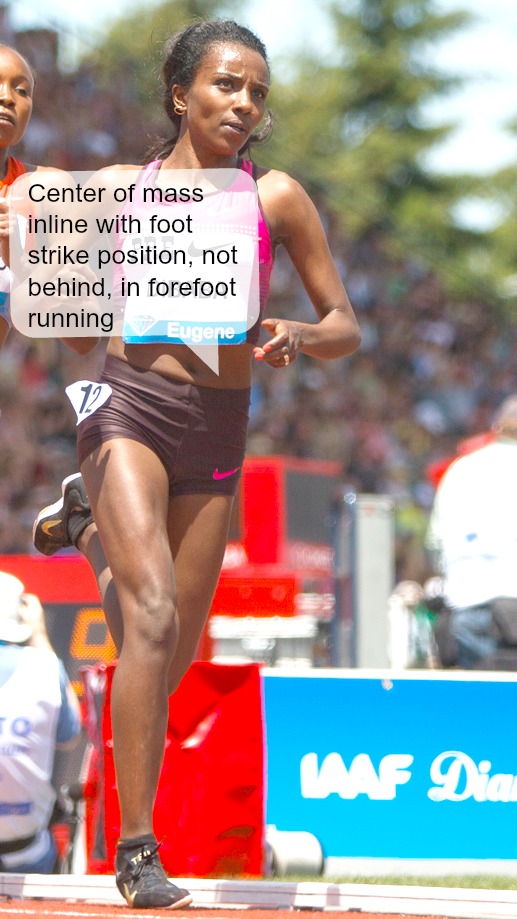Ground contact is longer in heel strike running than forefoot running because of 2 factors: 1. a posterior position of the center mass at foot strike and 2. foot rollover causes the foot to spend more time on the ground.
Why Ground Contact Time is Longer in Heel Strike Running than Forefoot Running
Ground contact time is the amount of time the foot interacts with the ground during the stance phase of running and long ground contact time is bad because there is more time for the braking force to decelerate forward motion of the body.
Ground Contact Time Affected by Position of Center Mass
If the center mass is behind (posterior) foot strike position as in heel strike running, ground contact time increases, shown below.

In contrast, if the center mass is more anterior relative to foot strike position, the ground contact time of the foot is much less, as in forefoot running.
- A more anterior position of the center mass is influenced by a subtle forward lean as per POSE Running and if you watch elite Ethiopian distance runners, they do not run upright, they actually fall forward a little compared to Non-African elite distance runners.
Danny Dreyer, founder of Chi Running, does a great job at explaining how to maintain an anterior position of the center mass during forefoot running whereby the torso (center mass) and the feet are racing against each other and the center mass is always winning and the feet are trying to catch up.
In heel striking however, the center mass is always kept behind foot strike position where at heel strike, the foot essentially waits until the center mass catches up to it. When the center mass is finally inline with the heel at heel strike, the foot rolls heel to toe while carrying the center mass over the entire foot where it is launched forward by the toes (propulsion phase).
Foot Rollover = Too Much Interaction Between Body and Ground
Foot rollover is a major component of heel running mechanics and is not observed in forefoot running.
Foot rollover occurs after the heel has contacted the ground where the foot rolls heel-to-toe. However, this action keeps the foot on the ground longer compared to a forefoot strike landing.
Again, foot rollover in heel running transfers the center mass positioned behind foot strike to the toes where it is propelled forward.
In a forefoot strike landing, the foot strike is a much flatter foot placement where the balls of the foot kiss the ground first and the rest of the foot flattens down quickly to the ground.
Because the center mass is always pushing forward in forefoot running, the feet are not used to propel the body. Instead, the feet serve as platforms for balance and prevent the body from falling when running.
Overall, in forefoot running, the center mass moves forward first, then the legs follow. Therefore, a forward fall drives forward momentum thus eliminating the action of foot rollover for propulsion.
More From Run Forefoot:
Having your toes spread is great for impact absorption and balance during running.
Why you should avoid running too upright with your upper body posture.
Reviews and recommendations on barefoot-like running shoes for forefoot running.
Natural remedies to soothe sore muscles.
References:
Kong, PW and Heer, H. Anthropometric, gait and strength characteristics of Kenyan distance runners. J Sports Med Sci, 2008; 7:499-504.
Bretta Riches
BSc Neurobiology; MSc Biomechanics candidate, ultra minimalist runner & founder of RunForefoot. I was a heel striker, always injured. I was inspired by the great Tirunesh Dibaba to try forefoot running. Now, I'm injury free. This is why I launched Run Forefoot, to advocate the health & performance benefits of forefoot running and to raise awareness on the dangers of heel striking, because the world needs to know.
Latest posts by Bretta Riches (see all)
- Can You Run In Barefoot Shoes? Yes, But DON’T Heel Strike! - 21/07/2024
- Why Cushioned Running Shoes Are Really Bad for Your Feet - 19/07/2024
- Do Cushioned Running Shoes Cause Injuries? - 17/07/2024



Leave a Reply